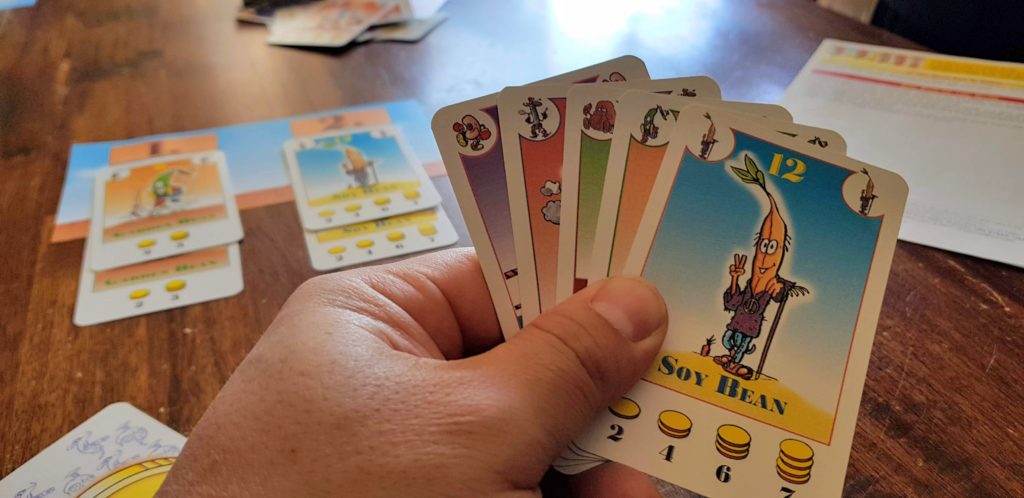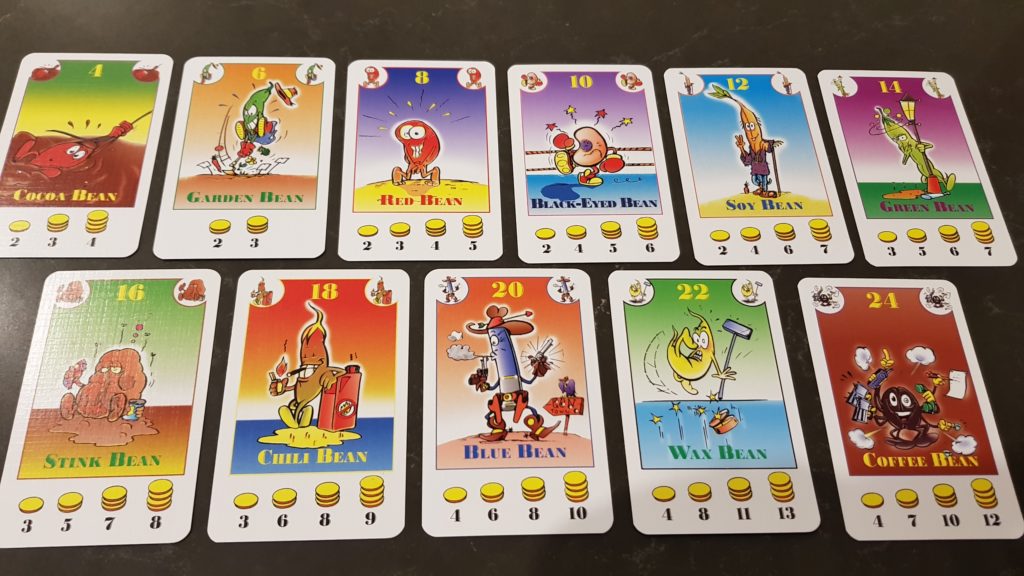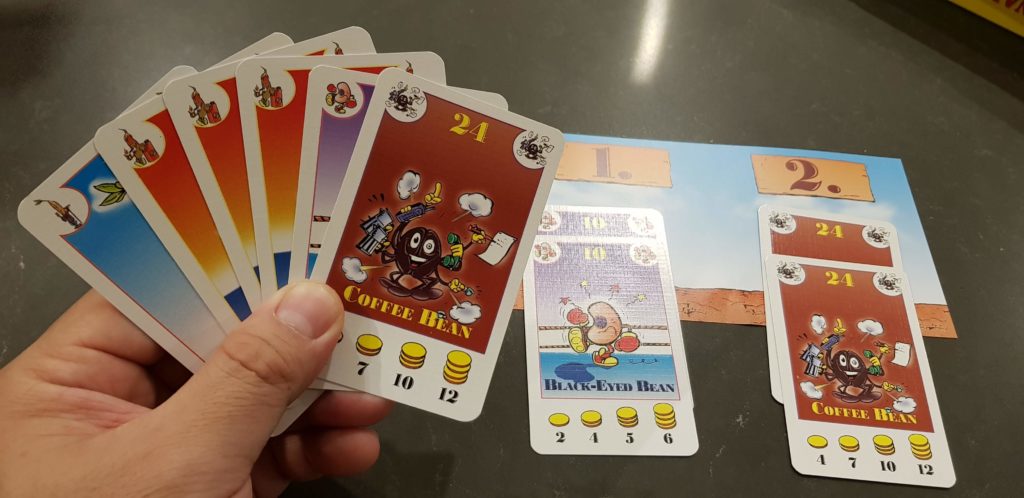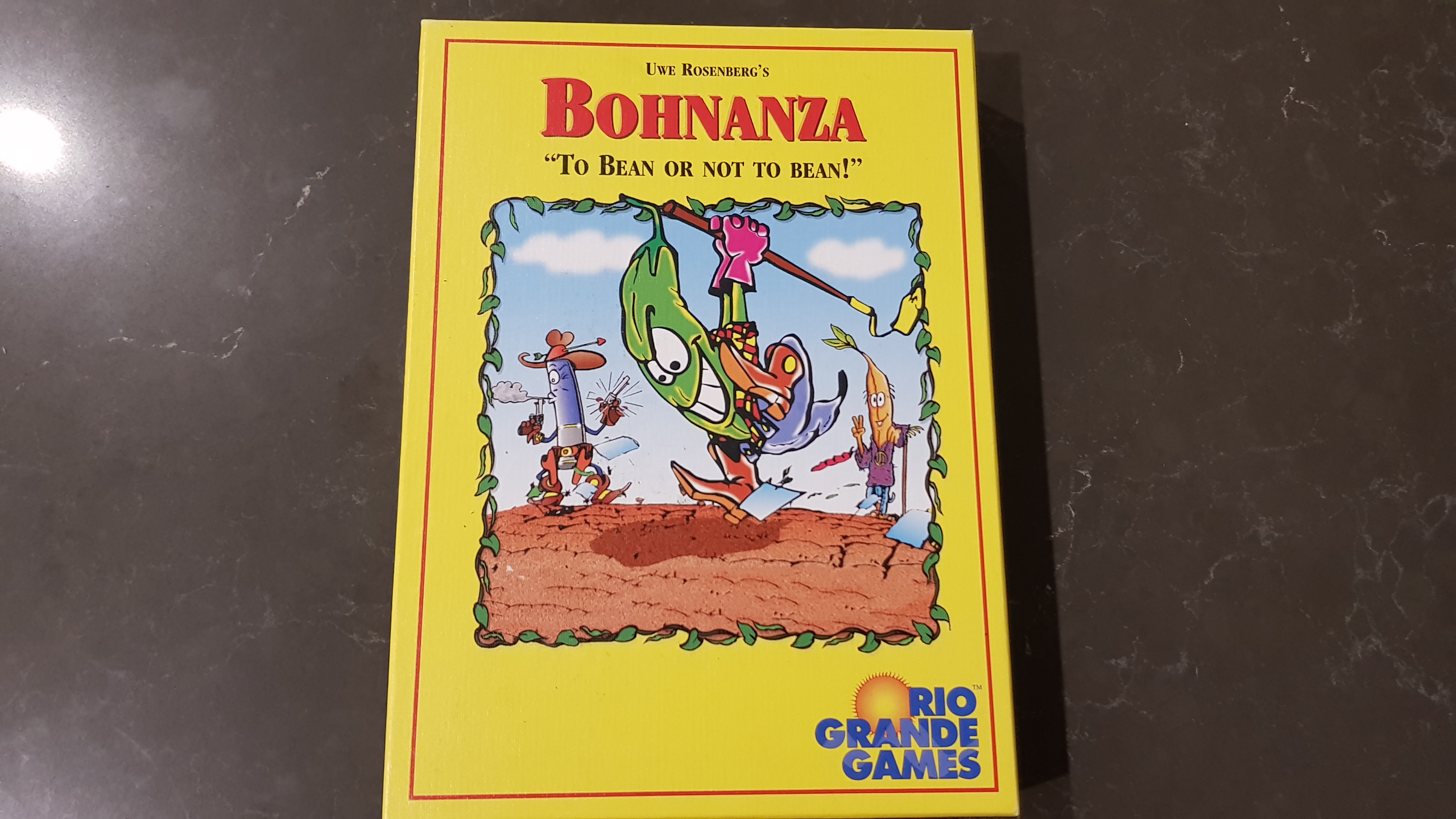It is safe to say that Uwe Rosenberg’s classic game, Bohnanza, is the best-selling and highest-rating board game about bean-farming. It is a bona fide classic and remains a high watermark of game design innovation, for it dares to create something that never existed before.
Let’s start with the theme. Bean-farming. Uwe Rosenberg is fond of gentle, uniquely-themed themes: mediaeval farming, walks in a New England forest, stone age farming, monastic life, Icelandic farming, walks in a Spring meadow, and bean farming. I can think of several games about Mars, or wine growing but only one about beans.
The name, Bohnanza, is a portmanteau of the word bonanza (a windfall) and Bohnen, the German word for bean, and it tells you almost everything you need to know about the game’s theme: you collect sets of beans to make cash. The player with the most cash wins.
Almost everything, because it won’t tell you that this continues to be one of the most innovative and least replicated designs in board games. Most other innovative games are quickly followed by imitators that create an entire genre: roll-and-write games, deck-building games, and so forth. The genius of this game is taking something basic and foundational to EVERY other card game and subverting it. It is such a unique subversion that no-one else dare copy it.

There are a million other games where you hold a hand of cards: from Bridge to Poker to Red7 to Magic: The Gathering to Mahjong. In literally every other game, your hand is an unordered set. You can sort it any way you want: by suit, by number, alphabetically or randomly. You draw cards and put them anywhere you want in your hand, then you play cards from anywhere in your hand.
Bohnanza might be the only game to take this fundamental mechanic of gaming and turn it in its head.1
The novelty in Bohnanza is that your hand of cards is ordered from front to back. New cards get placed in the back, cards at the front need to be planted.

In technical and actual terms, this is a queue. First bean in, first bean out. I imagine Uwe Rosenberg, inspired by spending several soul-sapping days in a queue. It is a game designers challenge: how you could add a slice of fun to this most dreary but necessary of human inventions? How could I turn this into a game–a game that is almost simple enough to play in a queue? Design a game around queues and add a dash of whimsy. The most obvious theme for this would be bean farming! After everyone in the queue is just a human bean… right?
Sidenote: actually this is my single biggest gripe about Bohnanza. Gil Hova and Geoff Englestein had a discussion on Ludology about ludonarrative dissonance, when gameplay and game theme are at odds. Bohnanza suffers from ludonarrative dissonance. The gentle theme with the cutest of artwork hides a brutal game where time marches on, beans pile up, and there is no space for sentimentality. The real life ebbs and flows of a season of real life bean farming becomes just a turn’s worth of frantic activity. Only harsh economic realities keep any bean around for longer than a turn.
Despite my religious convictions, I am, by nature, cynical of the human condition. I imagine a bleak lesson in mortality. The fleeting nature of this mortal coil, relentlessly shuffling on. You can’t stop this process, merely manipulate the contents of your hand to get the outcomes you want. Subsequent forgotten generations in Crusader Kings II, all chasing power and wealth which only last but a moment. Not the most appealing of game themes.
This might be why I write about games instead of designing them.
Nevertheless, I lie awake in bed at night dreaming how I would re-theme it. A better theme might be a conveyor belt, beans relentlessly moving from hand to garden to your piggy bank every turn. A game about overly-competitive supermarket cashiers? Competing coffee carts? Conveyor belts in a factory?

But, this game. Its about collecting beans. Ordinary, everyday beans (with amazing, life-bringing art work, courtesy of Björn Pertoft). Your hand is a queue of beans. Beans join the back of your hand, and leave from the front.
Or, they can leave. Similar to a supermarket, beans can always leave, but they have to join the back of someone’s queue (hand). This is the second major mechanic of the game: trading. Because we care about our queues, not our beans, a clever player trades beans to remove beans they don’t want to plant, and arrange their hand for maximum profit.
The hardest thing about this game is simply this: overcoming your muscle memory. I spent the vast majority of high-school lunch hours playing 500 or Big 2. So many hands of cards. Pick up a hand, fan left, fan right, sort your hand. Idly shuffle to appear cavalier, then sort again, surreptitiously. Nope. Can’t do any of that any more.

Once you’re past that, it becomes an easy entry set-collection / trading game, trying to manipulate the queue of beans in your hand so can accumulate the same sort of beans in your bean fields for maximum profit. The more beans you collect, the more valuable, because no doubt you’ve exerted so much effort to keep them being overrun by all the other beans you could have planted.
My kids can play, beguiled by the hilarious illustrations and the absurdity of statements like, “I’ll trade you two Stink Beans for a Chili and a Black-Eye.”
Though queuing seems far-flung from bean-farming, it is such a familiar and fundamental human activity, drilled into us from, young age. For that reason, Bohnanza is a family-friendly game, and easy to introduce to the gaming muggle.
Despite whatever the game might say about mortality or the passage of time, or perhaps the tragi-comic absurdity of all of us human beans shuffling off this mortal coil to be buried in the ground, the game itself has stood the test of time. It stays on my shelf, still getting played. Waiting patiently. It belongs in your collection too. Add it to your queue.
